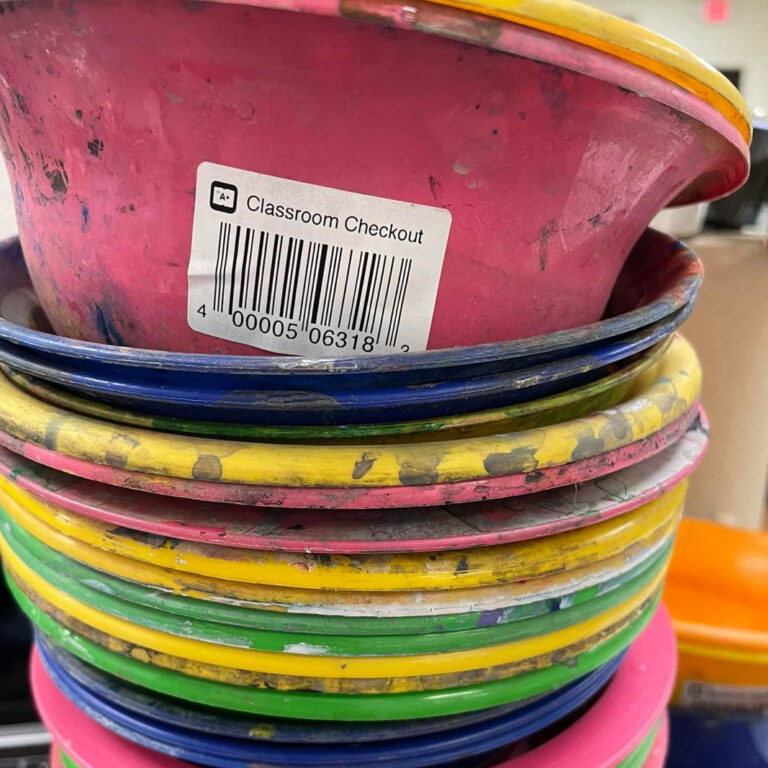 A common complaint of art teachers is the destruction of art materials by students. You know the behaviors; particularly the bent or broken rulers and erasers that you find carved, stabbed, or broken. Middle school is the age where these behaviors seem to peak but it’s still evident in lower-level high school classes. In my first few years of teaching, I vividly recall ninth-grade classes where students would put slits into Elmer’s glue bottle. It would seal itself up only to have a student later in the day squeeze it and have glue pouring out on everything. Moments like that really damage your psych and have you questioning your career
A common complaint of art teachers is the destruction of art materials by students. You know the behaviors; particularly the bent or broken rulers and erasers that you find carved, stabbed, or broken. Middle school is the age where these behaviors seem to peak but it’s still evident in lower-level high school classes. In my first few years of teaching, I vividly recall ninth-grade classes where students would put slits into Elmer’s glue bottle. It would seal itself up only to have a student later in the day squeeze it and have glue pouring out on everything. Moments like that really damage your psych and have you questioning your career
Why do they do it? Poor impulse control? Frontal cortex still developing? Lazy and careless? As one teacher observed, “The kids usually doing the destroying are the ones who struggle with the creating.” Whatever the cause, here are varied strategies from art teachers for combating destructive behaviors.
Structure and systems
Keep things structured and students busy. Utilize bell ringers and other routines that have students start to work the moment they enter the classroom. Project what the class is doing that day, what they will need for class, and keep them working. Set a timer for when they can begin cleaning up and keep them busy until the bell rings for departing. Exit slips can keep students busy while keeping them accountable.
Stress how students are to care for classroom materials (and how NOT to use the material) from day one and go over rules weekly or even daily if needed. Tell your students no sword fighting, tapping, or bending of rulers. Make caring for materials part of every demonstration. Have students write rules down the rules and quiz them on the rules. One teacher explains her strategy, “I started keeping the old misshapen rulers and before I passed them out I gave a speech to every class before use which included that we would be using them in the spring and perspectives was much easier with well-treated rulers. It reduced my rulers being tortured.”
Give daily points for studio behaviors. If they are not on task students lose points. They can also lose points for not cleaning up and for disruptive behavior. One teacher reports improved grades and better quality of work and less attitude with this system.
Have firm consequences for destructive actions. Consequences can include loss of supplies, call home, write-ups for the destruction of school property, etc. Never threaten anything you do and be consistent with expectations.
Pick materials based on the age and maturity level of your classes
I taught at a private school with a teacher who bought premium supplies all the time. My background is in public schools, I never had the budget before to buy premium supplies. It’s nice, for sure, but I am not sure that her students’ work matched the quality of the supplies. You can make great things with very little. Pick and choose who deserves- and is developmentally ready to appreciate the better supplies. Make students earn access to all but the most remedial of supplies. Hence the old expression “This is why we can’t have nice things”
Know your student and think through the materials you provide. Some classes just aren’t ready to handle some supplies, so modify your curriculum as needed and consider what you provide carefully. Maybe your older high school students can use your metal rulers but that intro class, maybe they just get cut scrap mat board for a straight edge when teaching perspective.
Other ways to make life easier:
- Don’t use palettes if they aren’t good at cleaning. Use wax paper or pallet paper for mixing. ( or magazines, just rip a fresh page and toss the used one).
- Number the erasers and create a “parking garage” for the erasers.
- Have students check out materials that are important and often target for destructive behavior such as Xacto knives. Or collect collateral in exchange for the material. A shoe for a ruler. The student only gets his or her shoe back if the ruler is in the condition you loaned it out in.
- Lock everything up, except drawing paper and pencils, when you are not there.
- Task students with classroom jobs. Art teacher Dáirinn Smith shares, “I have an art monitor. Alphabetically chosen from the roster once a day. Polices sinks and supplies and has to do the work themselves if their classmates don’t. Which gets the peers on the rant not just us. And they respond better to peers. If 20-30 kids they’re only doing it once every month or two.”
- Consider kits with the materials needed for the class. Many teachers started with kits during the pandemic and found them so successful they have continued the trend. Knowing these are their own supplies and won’t be replaced motivates students to care for them more than “school” supplies.
- If you can, have students buy a certain amount of their own supplies. A Sharpie, sketchbook, eraser, etc.
Create a calm atmosphere
Destruction is thought to be a result of stress, frustration, anger, immaturity, and overstimulation. So, do what you can to create an environment that is calming.
I walked into my art teacher’s neighbor’s classroom and I will never forget the calm that her class radiated. I was struggling to reign in a class that had a string of subs while her class was quietly painting while the teacher read poetry to them. I wouldn’t have believed it if I hadn’t witnessed it with my own eyes. So, strive to create a classroom of calm. Try meditation, music, dim lights, and a soft soothing voice. Greet your students at the door and don’t even let them in until they are calm. One teacher advises, “Speak in a hushed whisper and talk about how the art room is a chill space. Recognize that some of them might need to step outside for a few minutes until they can be chill, but make it sound a teeny bit uncool to be the kid who is being disruptive. Keep projects super simple and reward good art room habits.”
Another tried and true strategy to win students over is to focus on building relationships with your students. Students appreciate when a teacher is interested in them as a person. Ask about the big game over the weekend on Monday. Or ask how the play rehearsal is going if they have a part. I used to ask students to fill out a questionnaire that was quite extensive just so I could learn about my students. I would ask about their pets, music taste, sports, etc. And I would create playlists with everyone’s favorite tunes. Relationships would flourish over a shared love of our cats. And when students like an adult, they are less likely to be destructive.




